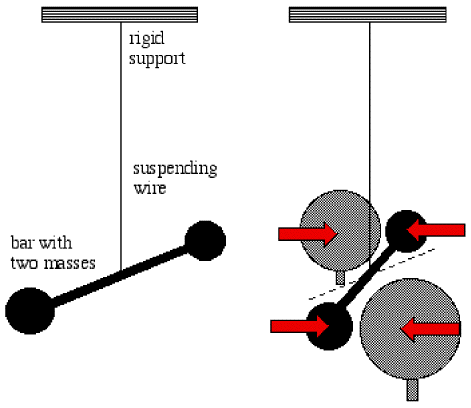Definition
Gravitational Constant
The gravitational constant (G) is a proportionality constant that appears in the equation for Newton's law of gravitation. The value of G is approximately equal to .
Definition
Gravitational unit of force
Some common Gravitational units of force are:
- kgf: Amount of gravitational force on of an object.
- gf: Amount of gravitational force on of an object.
- N: SI unit of force, force required to accelerate a body of 1 kg by
Result
Characteristics of Gravitational Force
1. It is a universal attractive force.
2. It is directly proportional to the product of the masses of the two bodies.
3. It obeys inverse square law. It is a long range force and does not need any intervening medium for its operation. Gravitational force between two bodies does not depend upon the presence of other bodies.
4. It is the weakest force known in nature. It is a central force (i.e., it acts along the line joining the centres of the two bodies). It is a conservative force (i.e., work done in moving a body against the gravitational force is path independent). Gravitational- force between two bodies is thought to be caused by an exchange of a particle called graviton.
2. It is directly proportional to the product of the masses of the two bodies.
3. It obeys inverse square law. It is a long range force and does not need any intervening medium for its operation. Gravitational force between two bodies does not depend upon the presence of other bodies.
4. It is the weakest force known in nature. It is a central force (i.e., it acts along the line joining the centres of the two bodies). It is a conservative force (i.e., work done in moving a body against the gravitational force is path independent). Gravitational- force between two bodies is thought to be caused by an exchange of a particle called graviton.
Definition
Universal Law of Gravitation
Newton's law of universal gravitation states that any two bodies in the universe attract each other with a force that is directly proportional to the product of their masses and inversely proportional to the square of the distance between them.
Mathematically,
where, = Gravitational Force
= Universal Gravitational Constant
are masses of bodies
= distance between their centre
Mathematically,
where, = Gravitational Force
= Universal Gravitational Constant
are masses of bodies
= distance between their centre
Definition
Importance of Universal Law of Gravitation
Following are the importance of the universal law of gravitation:
- It explains the force of gravitation acting between two bodies.
- It describes the phenomenon of revolution of heavenly bodies.
- It determines the downward force on the surface of the earth.
Definition
Force due to gravity
Gravity is the force applied on an object on the surface of earth. It is always directed in the downward direction(i.e. towards the center of earth). It is approximately constant in magnitude. Its value is given by where .
Example
Gravitational force between two objects
For a set masses and separated at a distance of , according to Newton's law of gravitation gravitational force will be:
Example
Understanding Earth's gravitation using universal law of gravitation
A satellite is moving in a circular orbit round the earth. If gravitational pull suddenly disappears,then it moves with the same velocity tangential to original orbit. The reason being, for a body revolving around any object, it is bound by the centripetal force by the object on the body. This force is along the line joining the body and the object. But the velocity of the body will be perpendicular to this force, that is tangential. In this case, when the gravitational force becomes zero, there is no binding on the satellite to revolve around the Earth. Since it was moving with a velocity '' in the tangential direction, it continues to move in the same direction with the same velocity '' to conserve the momentum.
Example: Keep a stone on a rotating wheel. Stone will fly off the wheel tangential to the wheel's radius.
Example: Keep a stone on a rotating wheel. Stone will fly off the wheel tangential to the wheel's radius.
Example
Problems involving universal law of gravitation
Example: If and are gravitational and electrostatic forces between two electrons at a distance then
is in what order?
Solution: Gravitational force
Electrostatic force
where Universal gravitational constant and
and
Mass of an electron is and Charge of an electron is
Hence, is of the order of
is in what order?
Solution: Gravitational force
Electrostatic force
where Universal gravitational constant and
and
Mass of an electron is and Charge of an electron is
Hence, is of the order of
Definition
Experimental method to determine the value of gravitational constant

The experimental setup performed by Cavendish is shown in the attached figure. Two masses are attached to the end of a horizontal suspended bar. Then, two large lead spheres are brought close to the small ones but on opposite sides. There is no net force on the bar but a non-zero torque acts on it caused due to gravitational force of attraction. This cause twisting of the suspended wire until a maximum angular displacement. At the point of maximum angular displacement, restoring torque is equal and opposite to the gravitational torque.
where is the restoring couple per angle of twist and is constant for a given material.
where is the restoring couple per angle of twist and is constant for a given material.
| BookMarks |
0 Comments
Post a Comment